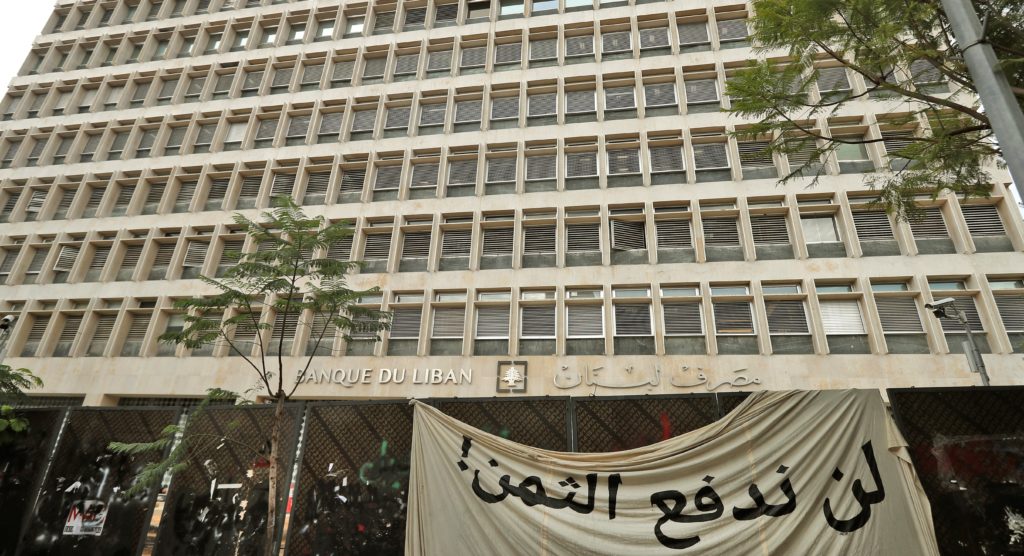According to the governor of the Lebanese Central Bank (BDL), Riad Salamé, the country’s banking sector should resume work in March 2021, thereby referring to the 20% recapitalization effort Lebanese banks are required to complete. In several interviews Salamé indicated that banks failing to comply with the requirements should be out of the market by February, which justifies making March such a pivotal milestone for banks to regain their role and resume their work, consequently, restoring the Lebanese deposits.

The recapitalization process is based on the idea that bank owners themselves increase their capital in the banks, using their assets or funds to improve the banks’ capacity to absorb losses, and to provide them with the cash needed to perform their traditional roles.
The BDL has laid down a set of conditions in various circulars to give the impression that this course of action is sufficient to solve the financial sector’s problems. The most important condition being the requirement to increase the banks’ capital by 20%, in addition to increasing funds in foreign banks (correspondent banks) by 3% of total deposits.
However, the BDL’s governor’s promises aside, a simple review of the total losses already inflicted on the financial sector suffices to realize that recovering deposits, or reconstructing them, is a much more complicated affair and cannot be resolved by the BDL circulars.
Furthermore, a simple review of the circulars makes one realize that they will never contribute to a real recapitalization, but only to a formal accounting process that serves no purpose. Most importantly, the consequences of these circulars would harm depositors more than would benefit them, and the recent steps taken by the BDL prove that.
In short, the deposit crisis shall continue and may even be exacerbated.
The Real Volume of Losses
When we talk about the banking sector’s failure and inability to meet its obligations towards depositors, we are talking about foreign-currency-denominated deposits in particular. The BDL can create cash to meet its obligations to banks in Lebanese pounds. It can also lend the state Lebanese pounds to pay its obligations denominated in Lebanese pounds to banks. And both are currently doing so albeit under harsh restrictions to control the quantity of money in circulation to prevent a further depreciation in the Lebanese pound’s exchange rate.
Therefore, banks have no problem to pay their liabilities in Lebanese pounds, even if there are certain restrictions. The main problem lies in the banks’ foreign-currency-denominated deposits at the BDL, which the latter has failed to pay back.
In return for the considerable amount of liabilities in foreign currency, the banks still have some $9.9 billion worth of Eurobonds, sovereign debt bonds in hard currency, the state has failed to pay. Settlement depends on negotiations with the currently non-existent Lebanese government.
The banks also have about $21.48 billion worth of loans to the private sector. However, the overwhelming majority is paid in Lebanese pounds or bank checks, while the default rate for these loans exceeds 25%. Therefore, these loans are not an actual source of cash dollars.
Concerning the assets in foreign banks, accounts at corresponding banks and investments abroad, one should know there are foreign liabilities in return as well. The net liabilities and assets amount to a deficit of $2.87 billion, according to BDL statistics. This means banks cannot rely on such assets at the present time.
The greater share of bank assets in US dollars has been transferred to the BDL, as the banks were involved in the BDL financial engineering mechanisms of the past few years. Bank deposits in hard currency at the BDL exceed $80 billion, most of which has already been spent by the BDL with the aim of defending the Lebanese pound’s fixed exchange rate and financing imports. What remained by mid-December, according to BDL figures, did not exceed $19.85 billion.
In other words, although banks owe depositors $112.19 in foreign currency, they do not have the assets to obtain cash dollars, apart from the $19.85 billion left at the BDL, yet most of this represents the minimum reserve requirements that cannot be used. Meanwhile, the BDL continues to depend on this money to finance imports. In any case, the BDL’s remaining liquidity ratio, compared to the volume of deposits denominated in foreign currencies, does not exceed 18%.
Besides these approaches based on comparing the volume of deposits to the volume of the remaining liquidity, financial advisory firm Lazard estimated the financial sector’s accumulated losses at some $83 billion – before Lebanon demanded the company to alter its approach and assess the losses in Lebanese pound.
Real Estate
Facing the huge losses, the recapitalization process undertaken by the BDL does not seem to provide any serious solutions. The banks’ combined capital is currently barely worth $18.82 billion. Increasing it by 20%, as requested by the BDL, will not gather more than $3.8 billion, which is peanuts compared to the current losses.
Yet, the fragility of the BDL recapitalization effort stems not only from its humble size but also from its form and tools. Some of the BDL governor’s maneuvers have made it pointless. For example, the circulars allow banks to reassess the real estate they own, as well as the real estate from borrowers who defaulted in the past, in order to increase their capital. The BDL also allows the bank’s shareholders to increase capital by offering real estate, instead of providing actual funds.
Thus, the BDL achieved an increase in capital through bookkeeping and accounting operations that do not achieve any real change in the liquidity of banks and their ability to meet their obligations to depositors in the future, especially seeing the current situation in the real estate sector. In reality, the only condition in all these BDL circulars that will actually provide improved liquidity is the demand for banks to increase liquidity at corresponding banks by 3% of total deposits.
It seems that major banks will be able to do so by selling foreign assets, represented by their branches abroad. However, securing this liquidity at corresponding banks is not accompanied by any conditions regarding the use of this liquidity, especially since Lebanese banks suffer – as we mentioned – from a $ 2.87 billion deficit.
In other words, it is expected that this new liquidity will help banks meet their foreign obligations, but will not offer anything new for depositors in Lebanon.
Will Banks Comply?
Despite the facilities provided by the BDL, and the fragility of this whole path in comparison to the gravity of the crisis, it does not seem most Lebanese banks are firmly on their way to comply with the conditions of recapitalization as laid down in the BDL circulars.
Admittedly, most of the banks in the last few months did not comply with previous requirements, such as preparing plans to increase capital or implementing the first phase of the increase. Nor did they meet the initial new year deadline set by the BDL governor. The reason is mainly the unwillingness of bank shareholders to take additional risks before having negotiated with the government and know the percentage of losses the banks will suffer.
In a nutshell, it should come as no surprise that the ballooning banking crisis is set to become more complicated this year. There is not a glimpse of the future breakthrough the BDL governor is promising.
As for the way to restore regularity to the functioning of the banking system, it must go through a full-fledged government plan to estimate the losses in the first place and determine how to distribute them equitably, given that the process of restructuring and recapitalizing banks is just one step in this full-fledged plan.
As for the BDL governor’s reliance on unilateral solutions, and his disregard for any integrated plan of this type, it will only produce very fragile ways ahead that will not offer depositors any real solutions.






